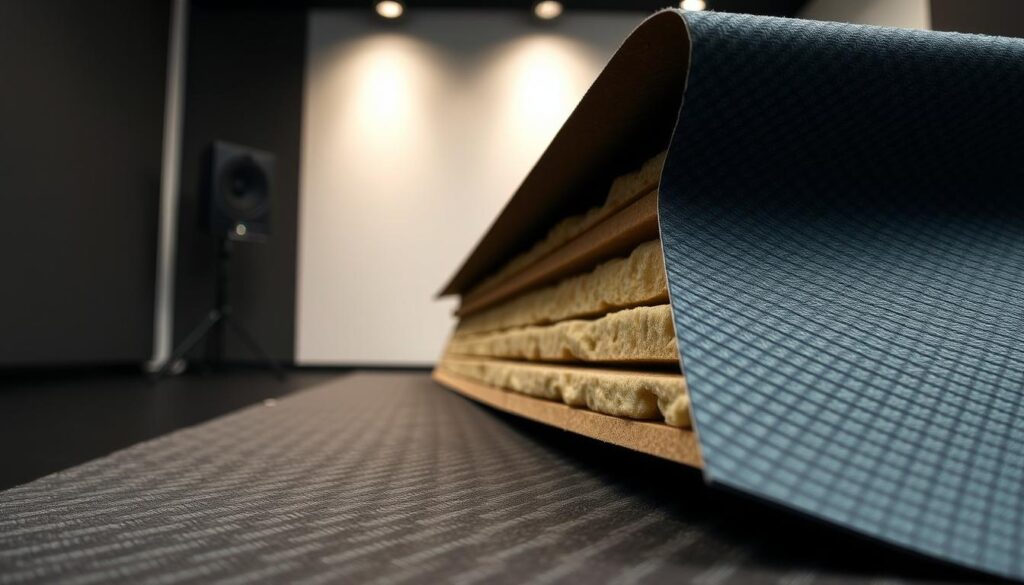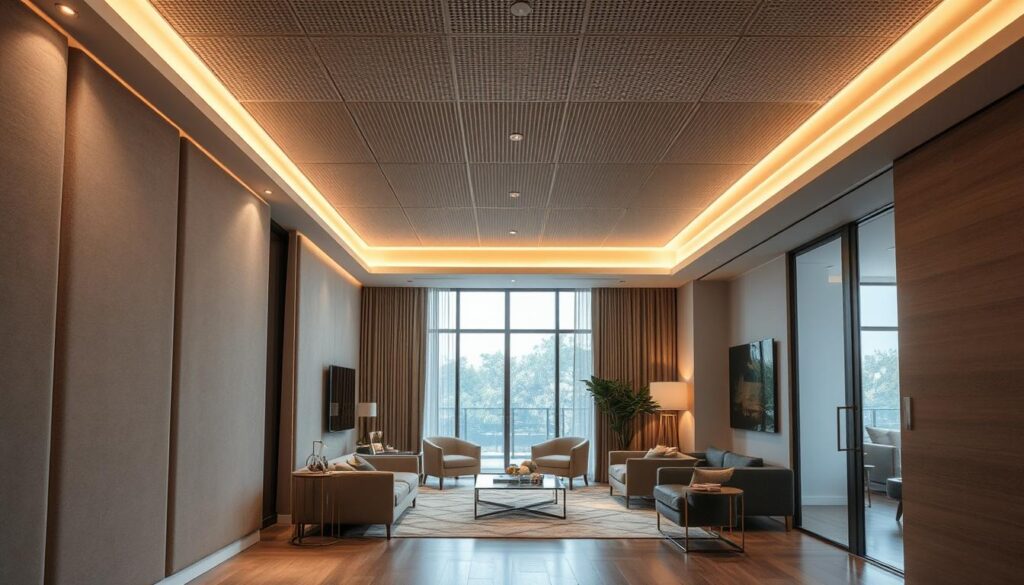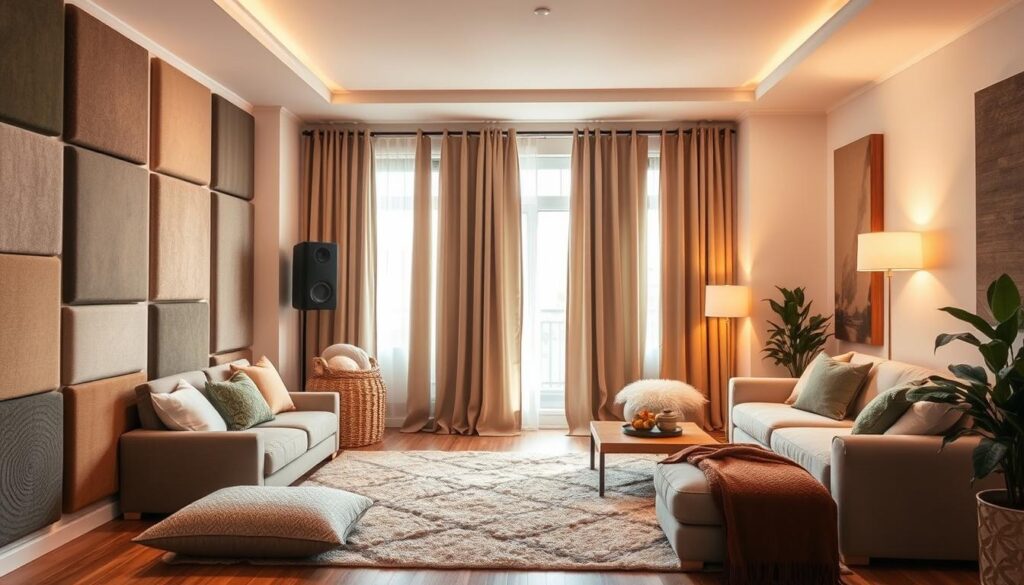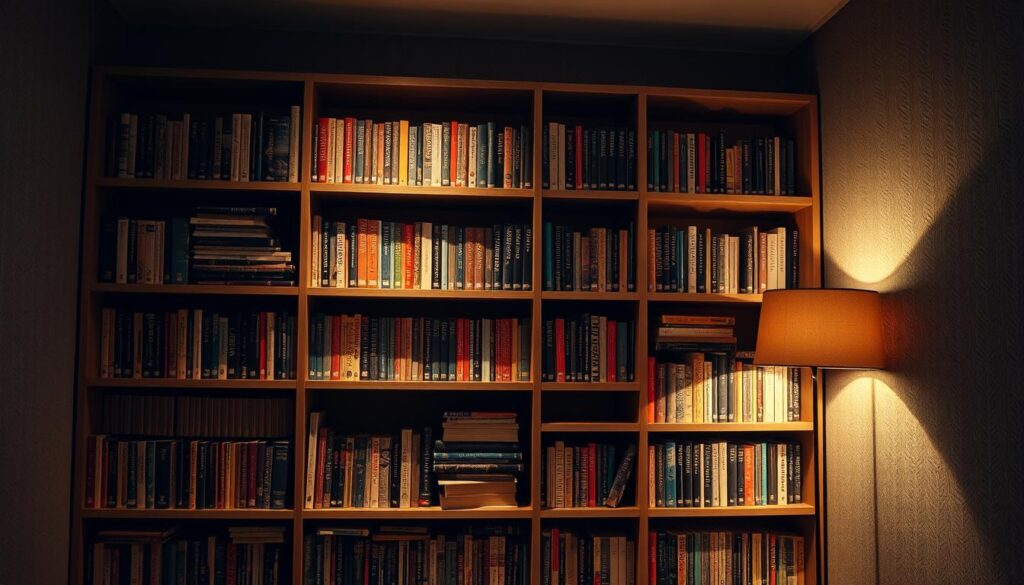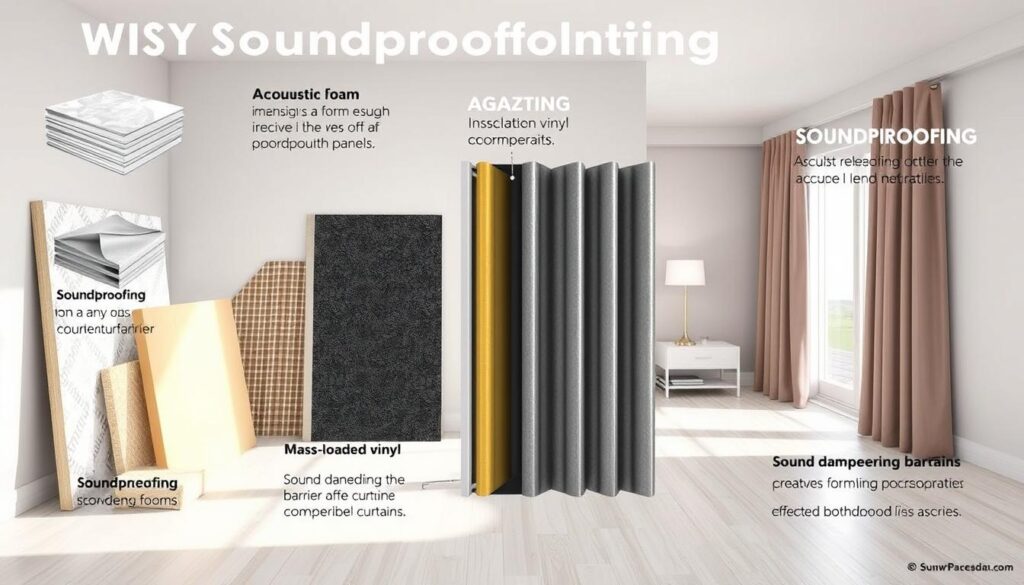Are you tired of unwanted noise disrupting your peace? Mass-loaded vinyl is a highly effective solution for soundproofing your home or office. This dense, thin, and flexible material is designed to block airborne noise. It’s perfect for walls, ceilings, and floors.
You can easily install mass-loaded vinyl to reduce noise transmission and create a more comfortable environment. Whether you’re setting up a home theater, recording studio, or just looking to minimize external noise, this soundproofing material is a great option. Its flexibility and ease of use make it a popular choice among homeowners and builders alike.
What is Mass-Loaded Vinyl?
Mass-loaded vinyl is a top-notch soundproofing material used for decades. It’s known for its unique mix and how well it works. It’s great for cutting down noise in many places.
Definition and Composition
It’s made from a soft vinyl sheet filled with heavy stuff like metal or barium sulfate. This makes it very dense, which is key for blocking sound. The material is limp and flexible, so it absorbs sound waves well instead of passing them on.
How it Works for Soundproofing
Mass-loaded vinyl is good at absorbing and spreading out sound energy. When sound hits it, the vinyl and fillers soak up the energy. This cuts down the sound that gets through. It’s a top choice for blocking noise, making rooms or buildings quieter. For more on soundproofing walls, check out our guide on soundproofing walls.
Knowing how mass-loaded vinyl works helps see its worth. It’s perfect for making spaces like home theaters, recording studios, or just quieter homes.
Benefits of Mass-Loaded Vinyl
Mass-loaded vinyl offers many benefits for soundproofing. It’s a favorite among DIY fans and pros for its effectiveness and simplicity.
Effective Sound Barrier
Mass-loaded vinyl acts as a strong sound barrier. It blocks airborne noise that can pass through walls, ceilings, and floors. Adding mass to surfaces absorbs sound energy, cutting down on noise transmission.
This is great for homes in noisy spots or rooms needing top soundproofing, like home theaters or recording studios.
Lightweight and Easy to Install
Despite being effective, mass-loaded vinyl is lightweight and flexible. It’s easy to handle and install. This makes it safe for various uses without harming structures.
It can be cut to fit and placed around obstacles for a smooth install. Whether you’re experienced or new to DIY, mass-loaded vinyl is a handy soundproofing option.
Choosing mass-loaded vinyl means picking a material that’s both effective and easy to use. Its soundproofing and ease of installation make it perfect for many projects.
Comparing Soundproofing Materials
Finding the right soundproofing solution can be a challenge. There are many materials to choose from, each with its own benefits and drawbacks.
You might have looked at mass-loaded vinyl, traditional insulation, acoustic foam, and decoupling methods. Knowing how these materials compare is key to choosing the right one for your needs.
Mass-Loaded Vinyl vs. Traditional Methods
Mass-loaded vinyl is a thin, flexible material that blocks sound well. It’s different from traditional insulation, which can be bulky and less effective at blocking certain sounds. Vinyl is thinner and more effective without taking up much space.
Key differences between mass-loaded vinyl and traditional insulation include:
- Flexibility and ease of installation
- Effectiveness against a wide range of sound frequencies
- Thickness and space requirements
| Material | Soundproofing Effectiveness | Ease of Installation |
|---|---|---|
| Mass-Loaded Vinyl | High | Easy |
| Traditional Insulation | Medium | Moderate |
| Acoustic Foam | Medium to High | Easy |
Performance Against Other Soundproofing Solutions
Comparing mass-loaded vinyl to other solutions like acoustic foam and decoupling methods shows their differences. Acoustic foam is great for absorbing sound in a room but not as good at blocking sound between rooms.
The choice between these materials depends on your specific soundproofing needs. For reducing echo and reverberation, acoustic foam is a good choice. But for blocking sound between rooms or from outside, mass-loaded vinyl is better.
Understanding the strengths and weaknesses of each material helps you make a better choice for soundproofing your space.
How to Measure Your Space for Soundproofing
To soundproof effectively, measuring your space is key. Whether it’s a home theater, recording studio, or noisy bedroom, knowing your space’s dimensions is essential.
The type and amount of material needed depend on your space’s size and layout. Mass-loaded vinyl is a top choice for soundproofing. It’s effective and easy to install. But, you must measure your space right to get enough material.
Determining the Area to Cover
First, find the surfaces causing the noise. This could be walls, ceilings, or floors. Measure their length and width in feet. For walls and ceilings, multiply length by height or width to find square footage. Floors are measured by length and width for square footage.
Don’t forget about obstacles like windows, doors, or ductwork. These need special care to ensure they’re sealed and soundproofed.
Calculating Material Requirements
After finding your total square footage, figure out how much mass-loaded vinyl you need. Most products are sold by the square foot. Match your total square footage to the product’s coverage area. Remember to add a little extra for cuts and irregularities.
It’s wise to talk to a pro or the manufacturer’s customer service. They can help you buy the right amount for your project. They’ll consider your space and the product’s features.
By measuring your space right and figuring out your material needs, you’re set for a successful soundproofing project. It will help reduce noise and enhance your space’s quality.
Installation Process of Mass-Loaded Vinyl
Installing mass-loaded vinyl is easy and can greatly improve your space’s soundproofing. To get the best results, start with careful preparation.
Preparation Steps Before Installation
Before starting, prepare your space well. Remove baseboards and check for gaps and cracks. Make sure the surface is clean and dry for a good installation.
- Clear the area of any debris or old adhesive.
- Check for any gaps or cracks and seal them with an appropriate sealant.
- Measure the space accurately to determine how much mass-loaded vinyl you’ll need.
Step-by-Step Installation Guide
After preparing your space, you can start the installation. Here’s a simple guide to help you.
- Cut the mass-loaded vinyl to the required size using a utility knife or a saw.
- Apply the mass-loaded vinyl to the surface, starting from the center and working your way outward to avoid air bubbles.
- Secure the vinyl with an appropriate adhesive or as recommended by the manufacturer.
- Seal the edges and any seams with a suitable sealant to prevent sound leakage.
To better understand the installation process, here’s a comparison of different methods:
| Installation Method | Effectiveness | Ease of Installation |
|---|---|---|
| Adhesive | High | Moderate |
| Mechanical Fastening | Very High | Difficult |
| Combination | Very High | Moderate |
By following these steps and choosing the right method, you can effectively soundproof with mass-loaded vinyl.
Considerations for Different Environments
The success of mass-loaded vinyl soundproofing varies by environment. Homes and businesses have different soundproofing needs.
Residential vs. Commercial Use
Homes and commercial buildings face different sound challenges. Homes need to block everyday sounds like family talks or TV. Commercial places, like offices or stores, must handle louder noises from machines or crowds.
Key differences between residential and commercial soundproofing:
- Noise levels: Commercial areas typically experience higher noise levels.
- Sound types: Residential areas deal with a wider variety of sounds, while commercial spaces often have more consistent noise patterns.
- Regulations: Commercial buildings must comply with stricter noise regulations.
Ideal Locations for Mass-Loaded Vinyl
Mass-loaded vinyl works well in many places. It’s great for:
| Location | Benefits |
|---|---|
| Home Theaters | Enhances viewing experience by reducing external noise and preventing sound leakage. |
| Recording Studios | Critical for achieving high-quality recordings by isolating sound. |
| Commercial Buildings | Effective in reducing noise pollution and improving overall acoustic comfort. |
Knowing your space’s needs helps you get the most from mass-loaded vinyl. It’s perfect for making your home theater better or improving office acoustics.
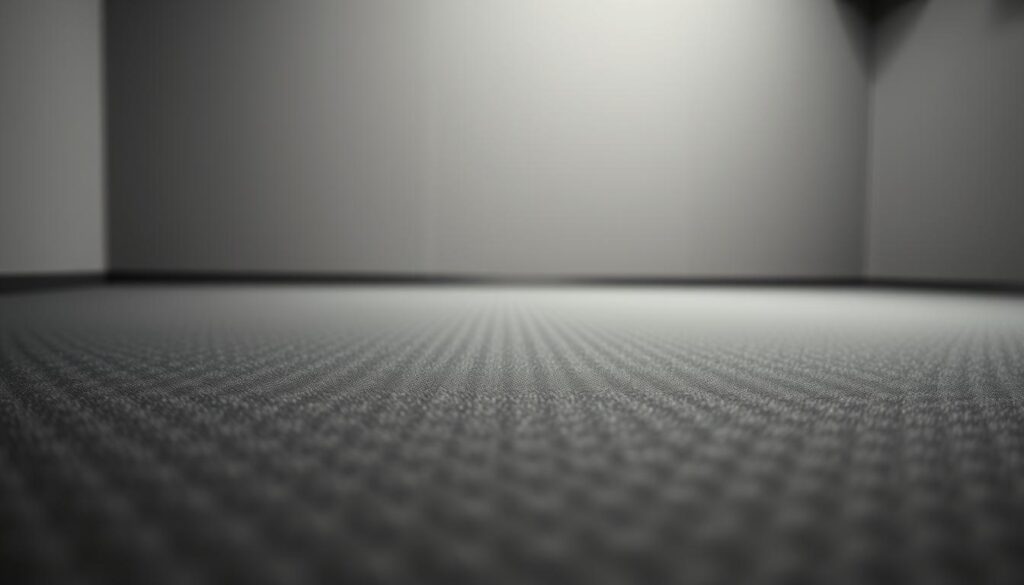
Enhancing Mass-Loaded Vinyl with Additional Materials
Adding mass-loaded vinyl and other materials to your soundproofing setup can greatly enhance your space’s acoustic performance. Mass-loaded vinyl is very effective, but mixing it with other materials can improve sound absorption and cut down on echo.
Combining with Acoustic Panels
Using acoustic panels with mass-loaded vinyl is a smart move. Acoustic panels soak up sound waves, which helps reduce echo and reverberation. This combo creates a top-notch soundproofing system that blocks sound and absorbs it too.
The perks of pairing acoustic panels with mass-loaded vinyl are:
- Sound absorption gets a boost, cutting down echo and reverberation
- Room sound quality goes up
- You get a better soundproofing setup that tackles sound control from all angles
Sealing Gaps for Maximum Efficiency
Sealing all gaps and edges is key to making mass-loaded vinyl work its best. Gaps around doors, windows, and joints can weaken its soundproofing. Use acoustic sealant or caulk to block sound leaks and keep your soundproofing strong.
Focus on sealing these areas:
- Door and window frames
- Joints between walls, floors, and ceilings
- Any spots for electrical outlets or switches
By mixing mass-loaded vinyl with acoustic panels and sealing gaps, you’ll get a soundproofing setup that really works. It will make your space’s sound quality much better.
Common Myths About Mass-Loaded Vinyl
Many people have wrong ideas about mass-loaded vinyl. It’s a popular choice for soundproofing, but its true effectiveness is often misunderstood. Here, we’ll look at common myths and set the record straight.
Debunking Misconceptions
One myth is that mass-loaded vinyl is hard to install. But it’s actually lightweight and easy to put up. This makes it perfect for DIY projects. With the right tools and patience, you can soundproof your space well.
Another myth is that it doesn’t work against airborne noise. But mass-loaded vinyl is great at blocking sounds like voices and music. It’s also good at stopping impact noise, like footsteps. Its dense, flexible material acts as a strong sound barrier.
- Myth: Mass-loaded vinyl is too heavy for ceilings.
- Fact: It’s dense, but safe for use on ceilings and walls without harming structures.
Facts Versus Fiction
Some think mass-loaded vinyl is only for commercial use. But it’s also great for home soundproofing. It works well in home theaters, bedrooms, or recording studios.
It’s also important to note that mass-loaded vinyl isn’t a one-size-fits-all solution. For the best results, use it with other soundproofing materials, like acoustic panels. Together, they offer top-notch soundproofing.
| Myth | Fact |
|---|---|
| Mass-loaded vinyl is difficult to install. | Mass-loaded vinyl is relatively easy to install. |
| Mass-loaded vinyl is not effective against airborne noise. | Mass-loaded vinyl blocks both airborne and impact noise. |
| Mass-loaded vinyl is too heavy for ceilings. | Mass-loaded vinyl is designed for use on ceilings and walls. |
Knowing the truth about mass-loaded vinyl helps you make better choices for soundproofing. Whether you’re at home or running a business, it’s a valuable tool for soundproofing.
Maintenance and Care for Soundproofing Solutions
To keep your soundproofing solutions working well, regular upkeep is key. It’s not just about keeping them looking good. It’s also about keeping them effective over time.
Cleaning Mass-Loaded Vinyl
Cleaning mass-loaded vinyl is simple but needs some care. Use a damp cloth to clean the surface. For tough stains, a mild detergent can help. But, stay away from harsh chemicals or abrasive cleaners that could harm the vinyl.
- Use a soft, damp cloth for general cleaning.
- Avoid using harsh chemicals or abrasive materials.
- For tough stains, mix a small amount of mild detergent with water.
Longevity and Durability
The life of your soundproofing solutions, like mass-loaded vinyl, depends on several things. These include the material’s quality, how it’s installed, and how well it’s maintained. If installed and cared for right, mass-loaded vinyl can last for years, keeping sound out.
Key factors affecting longevity include:
- Environmental conditions such as humidity and temperature changes.
- The quality of the installation.
- Regular maintenance practices.
By managing these factors and keeping up with maintenance, you can make your soundproofing materials last longer.
Budgeting for Your Soundproofing Project
A good budget is key to a successful soundproofing project. Knowing the costs is important when soundproofing a room or a whole house. This helps you choose the right materials and labor.
Several factors affect the cost of soundproofing. These include the area size, soundproofing materials, and whether you’ll do it yourself or hire pros. Mass-loaded vinyl soundproofing is popular for its effectiveness and easy installation.
Estimating Costs
Calculating the total cost involves materials, labor, and equipment. For DIY projects with mass-loaded vinyl, consider the vinyl cost, tools, and extra materials like acoustic panels. Professional quotes should include materials and labor.
Material costs depend on vinyl thickness and quality. Thicker, better-quality vinyl offers better soundproofing but costs more.
Finding Affordable Options
It’s possible to find affordable soundproofing without sacrificing quality. Compare prices for mass-loaded vinyl and other materials from different suppliers. Buying in bulk can save money on large projects.
Combining DIY and professional services can also save money. You can do simpler tasks yourself and hire pros for harder parts. This mix can keep your soundproofing budget in check while ensuring quality work.
Lastly, researching and comparing soundproofing solutions helps find the best value for your needs. Whether it’s mass-loaded vinyl, acoustic panels, or a mix, being informed helps stay within budget.
Success Stories: Real-World Examples of Soundproofing
Soundproofing success stories show how well mass-loaded vinyl works. People at home and in businesses have cut down on noise. This has made their places better and their lives better too.
Many families have made their homes quieter with mass-loaded vinyl. For example, a family in a loud area cut down outside noise by 80%. They put it in their walls and ceilings. Now, they have a quieter home, away from traffic and sirens.
Homeowners’ Experiences
People who soundproofed their homes with mass-loaded vinyl say it’s made a big difference. One person said it helped them work better in their home office. They could focus more and get more done. You can find out how to soundproof your home office here.
Commercial Applications That Worked
Businesses have also seen big improvements with mass-loaded vinyl. A recording studio used it to get top-notch sound isolation. This made their recordings better and kept neighbors happy. You can learn about soundproofing walls for different places here.
These stories show how mass-loaded vinyl works well in many places. Whether you’re at home or running a business, it’s a good choice for quieter spaces.
Conclusion: Is Mass-Loaded Vinyl Right for You?
Exploring mass-loaded vinyl for soundproofing shows it’s a top-notch solution. It’s effective at cutting down noise. Plus, it’s easy to put in place, making it great for homes and businesses.
Key Takeaways
Using mass-loaded vinyl for soundproofing has many benefits. It blocks a wide range of sounds, is light and flexible, and works well with different building materials. Adding it to your soundproofing efforts can make your space quieter and more peaceful.
Final Assessment
Mass-loaded vinyl is a solid choice for soundproofing. It’s effective, easy to use, and won’t cost a lot. It’s perfect for everything from home theaters to recording studios. Choosing it means you get top-notch soundproofing without spending too much.
